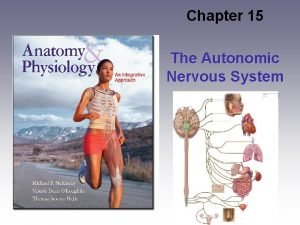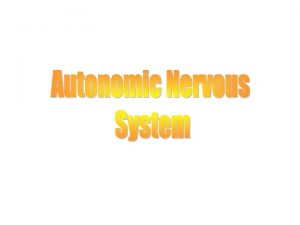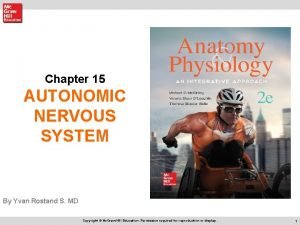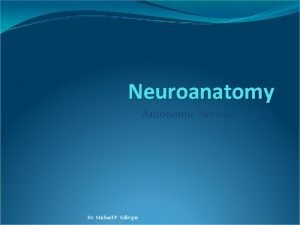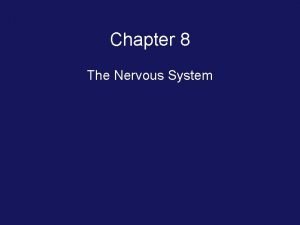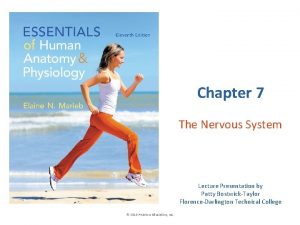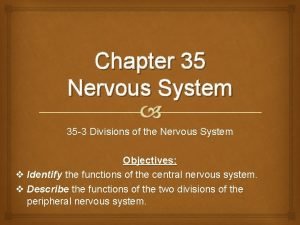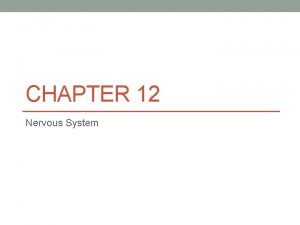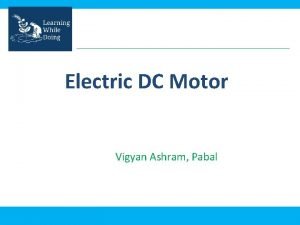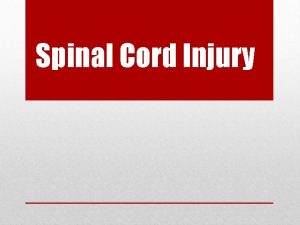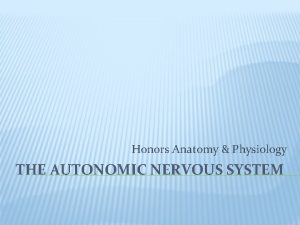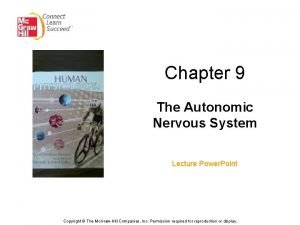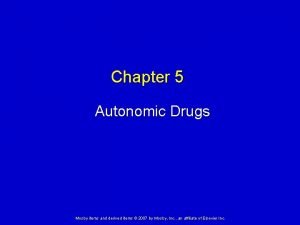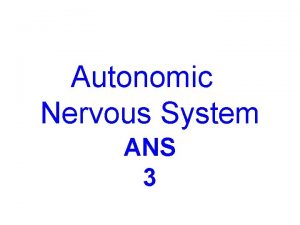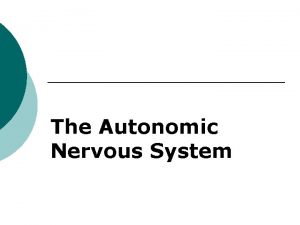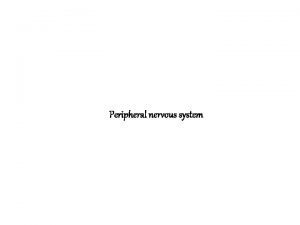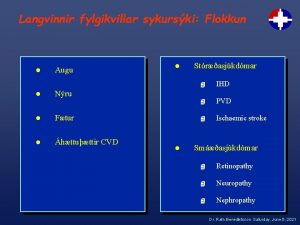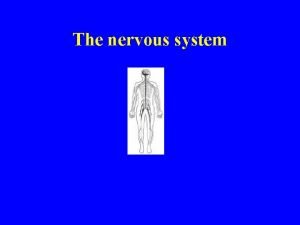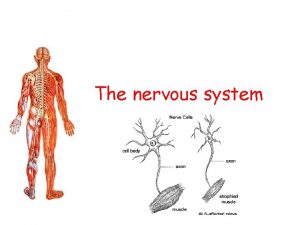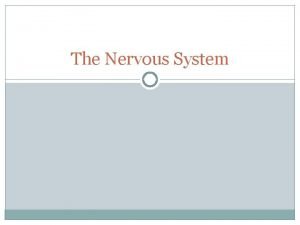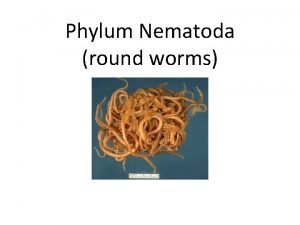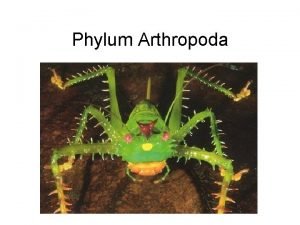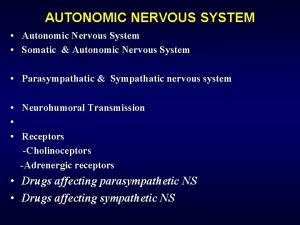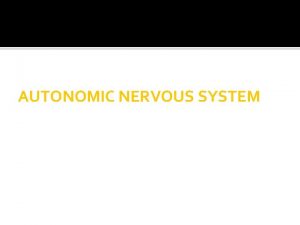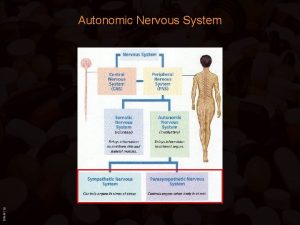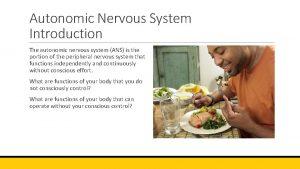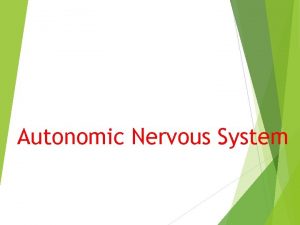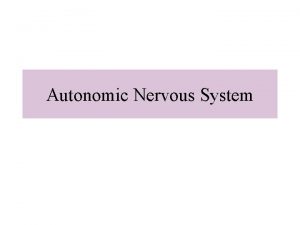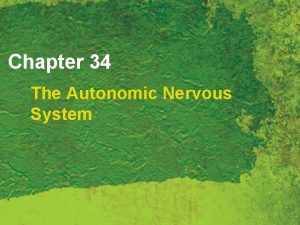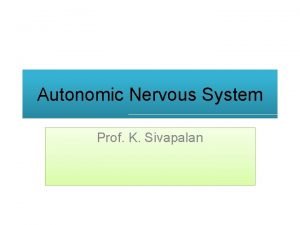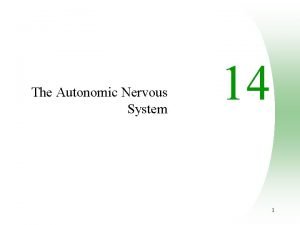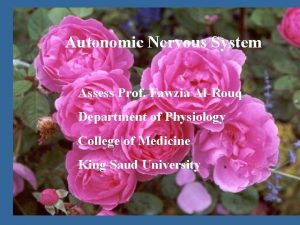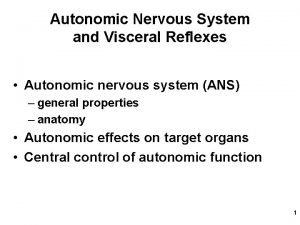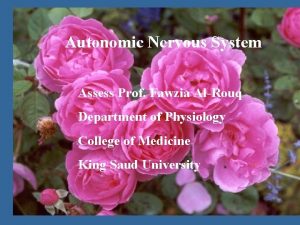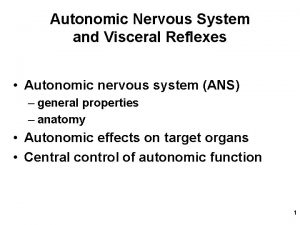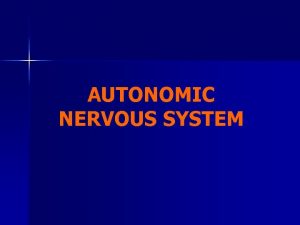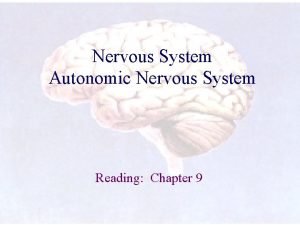Chapter 9 The Autonomic Nervous System Autonomic Motor

























































- Slides: 57

Chapter 9 The Autonomic Nervous System

Autonomic Motor Nerves Page 244 · Motor (efferent) division: Two subdivisions 1. Somatic nervous system 軀體神經系統 = voluntary 2. Autonomic nervous system 自主神經系統 = involuntary

Somatic vs. Autonomic System Page 245

Somatic vs. Autonomic System Page 244

Autonomic Neurons Page 244 • Somatic motor neurons have cell bodies in the spinal cord and just one neuron traveling from spinal cord to effector. • The autonomic motor system has two sets of neurons in the PNS. – The first has cell bodies in the brain or spinal cord and synapses in an autonomic ganglion. – The second has cell bodies in the ganglion and synapses on the effector.

Autonomic Ganglia Page 244 • Located in the head, neck, and abdomen as well as in chains along either side of the spinal cord

Visceral Effector Organs Page 245 • Somewhat independent of innervation and will not atrophy if a nerve is cut (unlike skeletal muscle) – Cardiac muscle and some smooth muscle contract rhythmically without nerve stimulation. Autonomic innervation can speed up or slow down intrinsic contractions. • Unlike somatic motor neurons (which are always stimulatory), autonomic motor neurons can stimulate or inhibit.

Autonomic Neurons Page 246 Preganglionic neurons: originate in the midbrain or hindbrain or from the thoracic, lumbar, or sacral spinal cord Postganglionic neurons: originate in ganglion

Comparison of Somatic and Autonomic Nervous Systems Page 245

Neurotransmitters Page 245 a. Somatic motor neurons release only acetylcholine which is always excitatory. b. Autonomic neurons release mainly acetylcholine and norepinephrine but may be excitatory or inhibitory

Parasympathetic vs Sympathetic Neurons Parasympathetic Division Preganglionic Long preganglionic axon neuron Ganglionic neuron Short Postganglionic axon Autonomic ganglion Sympathetic Division Short, branching preganglionic axon Long postganglionic axon Preganglionic neuron Ganglionic neuron Autonomic ganglion Page 246

Page 249 Sympathetic and Parasympathetic Divisions; the solid lines indicate preganglionic fibers, and the dashed lines indicate postganglionic fibers

Sympathetic Divisions Eye Blood vessels and Sweat glands of head Salivary glands Blood vessels Page 249 Heart Cardiac and pulmonary plexuses Superior cervical ganglion Middle cervical ganglion Inferior cervical ganglion Greater thoracic splanchnic nerve Lesser thoracic splanchnic nerve Postganglionic fibers to skin, blood vessels Least thoracic splanchnic nerve Lumbar splanchnic nerves Spinal cord T 1 T 1 T 2 T 3 T 4 T 5 T 6 T 7 T 8 T 9 T 10 T 11 Inferior mesenteric ganglion L 3 Sacral splanchnic nerves Sympathetic chain ganglia S 2 Stomach Spleen Adrenal medulla Superior mesenteric ganglion T 12 L 1 L 2 L 2 L 4 L 5 S 1 Lung Celiac ganglion Liver and gallbladder Hypogastric plexus Kidney Pancreas Large intestine Small intestine Rectum Bladder Vas deferens Seminal vesicle Prostate Ovary Uterus

Sympathetic Division Page 246 • Preganglionic neurons come from the thoracic and lumbar regions of the spinal cord. – Also called the thoracolumbar division • They synapse in sympathetic ganglia that run parallel to the spinal cord. – These are called the paravertebral ganglia. – These ganglia are connected, forming a sympathetic chain of ganglia.

Ciliary ganglion Lacrimal gland Pterygopalatine ganglion CN III Parotid salivary gland Submandibular salivary gland Sublingual salivary gland CN VII CN IX Pons Submanibular ganglion Page 249 Otic ganglion Heart CN X Cardiac plexus Pulmonary plexus Esophageal plexus Lung Esophagus Liver Gallbladder Stomach Spleen Kidney Ureter Abdominal Aortic plexus Spinal cord Pancreas Small intestine Hypogastric plexus Descending colon Rectum S 2 S 3 S 4 Pelvic splanchnic nerves Bladder Ovary Uterus Penis Scrotum

Autonomic Nervous System Page 248 & 249

Page 248 & 249

Sympathetic Preganglionic Neurons Page 246

Page 246

Sympathetic Neuron Pathways Page 247

Types of Sympathetic Pathways Preganglionic axon Posterior root ganglion Blood vessel Posterior root Hair Anterior root White ramus Lateral horn Cardiac plexus (parasympathetic fibers of plexus not shown) Arrector pili and sweat glands Spinal nerve Gray ramus White ramus Heart Sympathetic trunk ganglion Sympathetic trunk (a) Spinal nerve pathway (b) Postganglionic sympathetic nerve pathway

Types of Sympathetic Pathways Sympathetic trunk ganglion Gray ramus White ramus communicans White ramus Splanchnic nerve Adrenal medulla Preganglionic axon Splanchnic nerves Prevertebral ganglion (no synapse occurs) Intestine (c) Splanchnic nerve pathway (d) Adrenal medulla pathway

Collateral (Prevertebral) Sympathetic Ganglia Page 248 *The prevertebral ganglia differ from the sympathetic trunk ganglia.

Greater thoracic splanchnic nerve Trachea Sympathetic trunk ganglion Left vagus nerve (X) Right vagus nerve (X) Cardiac plexus Greater thoracic splanchnic nerve Pulmonary plexus Esophageal plexus Lesser thoracic splanchnic nerve Aorta Esophagus Diaphragm Celiac trunk (artery) Superior mesenteric artery Celiac ganglia and plexus Superior mesenteric ganglia and plexus Inferior mesenteric artery Inferior mesenteric ganglia and plexus Hypogastric plexus Abdominal aortic plexus

Collateral Ganglia Page 247 • Many of the sympathetic neurons that exit the spinal cord below the diaphragm do not synapse in the sympathetic chain of ganglia. • Instead, they form splanchnic nerves, which synapse in collateral ganglia. – Collateral ganglia include celiac, superior mesenteric, and inferior mesenteric ganglia. – Postganglionic neurons innervate organs of the digestive, urinary, and reproductive systems.

Adrenal Glands Page 247 • The adrenal medulla secretes epinephrine and norepinephrine when stimulated by the sympathetic nervous system. • Embryologically, the adrenal medulla is a modified ganglion and is innervated directly by preganglionic sympathetic neurons.

Parasympathetic Division Page 247 & 248 • Preganglionic neurons come from the brain or sacral region of the spinal cord. – Also called the craniosacral division • They synapse on ganglia located near or in effector organs. – Called terminal ganglia

Autonomic Functioning Page 247 · Sympathetic – “fight-or-flight” · Response to unusual stimulus · Takes over to increase activities · Remember as the “E” division = exercise, excitement, emergency, and embarrassment

Autonomic Functioning Page 247 · Parasympathetic – housekeeping activites · Conserves energy · Maintains daily necessary body functions · Remember as the “D” division - digestion, defecation, and diuresis

Page 247

Page 248

Neurotransmitters Page 251

Neurotransmitters of the Autonomic Nervous System Page 252

Adrenergic Synaptic Transmission Page 253

α and β Adrenergic Receptors • Two types of α (α 1 and α 2) • Two types of β (β 1 and β 2) • All act using G-proteins and second messenger systems. Page 253 – β receptors use c. AMP. – α receptors use a Ca 2+ second messenger system.

Page 255

α and β Adrenergic Receptors • Adrenergic effects in different organs Page 254

Response to Adrenergic Stimulation Page 252 • Can stimulate or inhibit, depending on receptors – Stimulation: heart, dilatory muscles of the iris, smooth muscles of some blood vessels (causes vessel constriction) – Inhibition: Bronchioles in lungs, other blood vessels; inhibits contraction and causes dilation of these structures

Response to Cholinergic Stimulation Page 256 • ACh released from preganglionic neurons of both the sympathetic and parasympathetic division is stimulatory. • ACh from postganglionic neurons of the parasympathetic division can be stimulatory or inhibitory, depending on receptors.

Two Classes of Acetylcholine Receptors Page 257 • Nicotinic: found in autonomic ganglia – Stimulated by ACh – Serve as ion channels – 270 k. D – consists of a, b, g and d – Each a-subunit possesses a binding site for acetylcholine

Nicotinic Receptor Page 257

Two Classes of Acetylcholine Receptors Page 257 • Muscarinic: found in visceral organs – Five types identified; can be stimulatory or inhibitory (opening K+ or Ca 2+ channels) – Use G-proteins and second messenger system – 70 k. D glycoprotein – 7 TMS family of receptor

Muscarinic Receptor Page 257

ACh Receptor Structure Page 257

ACh Receptor Function Page 257

Other Autonomic Neurotransmitters Page 258 • Some postganglionic autonomic neurons are not inactivated by drugs that block ACh or norepinephrine activity. • Called “nonadrenergic, noncholinergic fibers” • Proposed neurotransmitters include ATP, vasoactive intestinal peptide, and nitric oxide.

Page 258 (sildenafil) Viagra 威而鋼 phosphodiesterase GMP *NO can also produce smooth muscle relaxation in the stomach, intestines, and urinary bladder.

Organs with Dual Innervation Page 258 • Most visceral organs are innervated by both sympathetic and parasympathetic neurons. • Most of the time these systems are antagonists: – Heart rate – Digestive functions – Pupil diameter

Cooperative Effects • Occur when both divisions produce different effects that work together to promote a single action: Page 258 – Erection and ejaculation: Parasympathetic division causes vasodilation and erection; sympathetic causes ejaculation – Urination: Parasympathetic division aids in urinary bladder contraction; sympathetic helps with bladder muscle tone to control urination.

Complementary Effects Page 258 • Occur when both divisions produce similar effects on the same target – Salivary gland secretion: Parasympathetic division stimulates secretion of watery saliva; sympathetic constricts blood vessels so the secretion is thicker.

Page 259

Organs Without Dual Innervation Page 260 • The following organs are innervated by the sympathetic division only: – Adrenal medulla – Arrector pili muscles in skin – Sweat glands in skin – Most blood vessels • Regulated by increase and decrease in sympathetic nerve activity • Important for body temperature regulation

Control of ANS by the Brain Page 260 • Many visceral functions are regulated by autonomic reflexes. – Sensory input is sent to brain centers (usually by the vagus nerve), which integrate the information and modify the activity of preganglionic neurons. – Medulla oblongata controls many cardiovascular, pulmonary, urinary, reproductive, and digestive functions.

Regulation of the Medulla Page 260 • Higher brain regions regulate the medulla. – Hypothalamus: major regulatory center of the ANS – Limbic system: responsible for autonomic responses during emotional states (blushing, pallor, fainting, sweating, racing heart rate)

Function of ANS by the CNS Cerebrum Conscious activities in the cerebrum affect hypothalamus control of the ANS Hypothalamus Integration and command center for autonomic (visceral) functions; involved in emotions Brainstem Contains major ANS reflex centers Spinal cord Contains ANS reflex centers for defecation and urination

Autonomic Reflexes Page 261

Autonomic Reflexes Ureters Urinary bladder stretches 2 Nerve impulse travels through sensory neuron to integration center in the spinal cord 3 Nerve impulse is processed in the integration center Interneuron 1 Stimulus activates receptor Spinal cord 4 Motor impulses are conducted through motor neurons Preganglionic axon Postganglionic axon Ureter Urinary bladder Detrusor muscle contracts 5 Effector responds to impulse from motor neuron (smooth muscle contraction occurs in the bladder wall) Internal urethral sphincter relaxes
 Sympathetic nervous system def
Sympathetic nervous system def Autonomic nervous system pathway
Autonomic nervous system pathway Autonomic nervous system consists of
Autonomic nervous system consists of Ans
Ans Spinal cord dorsal and ventral roots
Spinal cord dorsal and ventral roots Autonomic nervous system
Autonomic nervous system The autonomic nervous system controls
The autonomic nervous system controls Visceral autonomic nervous system
Visceral autonomic nervous system Autonomic nervous system
Autonomic nervous system Interoreceptor
Interoreceptor What are the characteristics of nervous tissue
What are the characteristics of nervous tissue Nervous
Nervous Fundamentals of the nervous system and nervous tissue
Fundamentals of the nervous system and nervous tissue Autonomic motor neurons regulate visceral activities by
Autonomic motor neurons regulate visceral activities by Autonomic nerveous system
Autonomic nerveous system Nervous system and digestive system
Nervous system and digestive system Endocrine system vs nervous system
Endocrine system vs nervous system Endocrine vs nervous system venn diagram
Endocrine vs nervous system venn diagram Endocrine system and nervous system
Endocrine system and nervous system Componentes componentes
Componentes componentes Chapter 15 nervous system diseases and disorders
Chapter 15 nervous system diseases and disorders Chapter 8 the nervous system
Chapter 8 the nervous system Chapter 7 the nervous system figure 7-2
Chapter 7 the nervous system figure 7-2 Chapter 35 nervous system
Chapter 35 nervous system Chapter 14 lesson 3 the nervous system
Chapter 14 lesson 3 the nervous system Chapter 12 nervous system
Chapter 12 nervous system Pony motor starting synchronous motor
Pony motor starting synchronous motor Motor neuron
Motor neuron What is hunting in synchronous motor
What is hunting in synchronous motor Motor parts name
Motor parts name Ee 216
Ee 216 Anal wink reflex
Anal wink reflex Ans
Ans Autonomic ganglia
Autonomic ganglia Autonomic network management
Autonomic network management An architectural blueprint for autonomic computing
An architectural blueprint for autonomic computing Mosby items and derived items
Mosby items and derived items Autonomic drugs
Autonomic drugs The vision of autonomic computing
The vision of autonomic computing Ans hypothalamus
Ans hypothalamus Pns
Pns Autonomic computing ibm
Autonomic computing ibm Diabetic autonomic neuropathy
Diabetic autonomic neuropathy Autonomic bladder
Autonomic bladder Autonomic decision making
Autonomic decision making Chemical messengers of the nervous system
Chemical messengers of the nervous system Platyhelminthes examples
Platyhelminthes examples The nervous system is made up of
The nervous system is made up of Primary functions of the nervous system
Primary functions of the nervous system Learning objectives of nervous system
Learning objectives of nervous system Stimulus in nervous system
Stimulus in nervous system Nervous system objectives
Nervous system objectives Spinal nerves names
Spinal nerves names Sns pg
Sns pg The nervous system brain scienstructable
The nervous system brain scienstructable Nematoda
Nematoda Arthropoda
Arthropoda Nervous system of arthropods
Nervous system of arthropods





